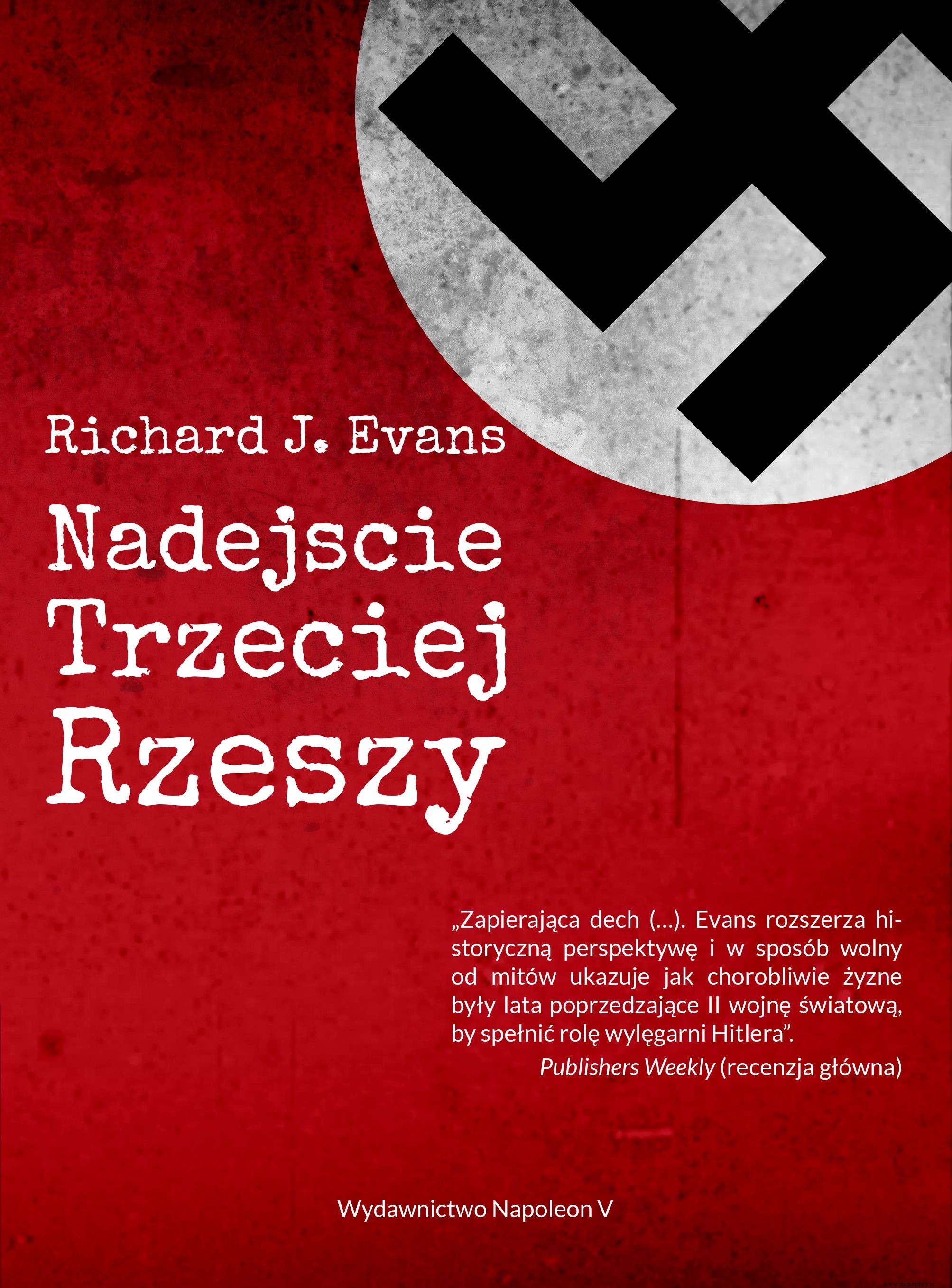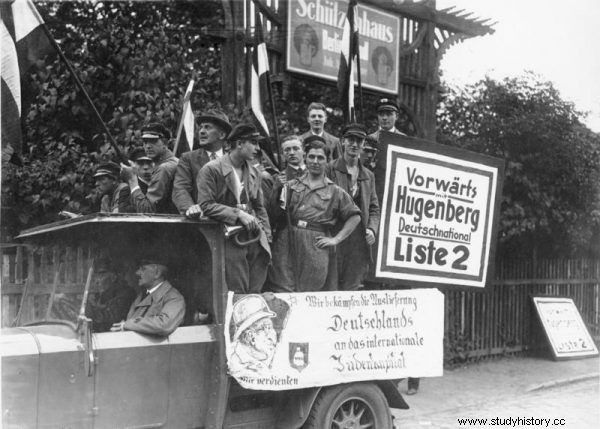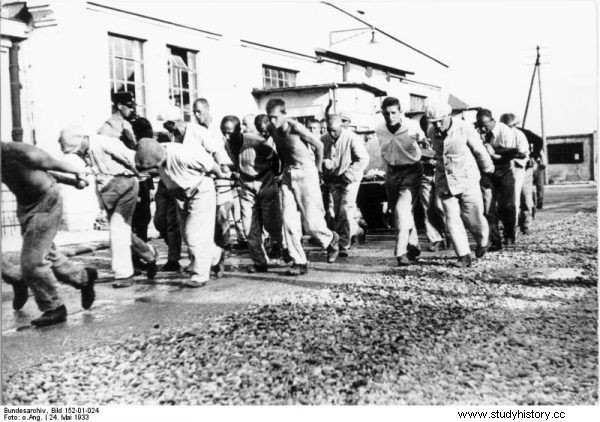Massive arrests, assaults, beatings, political murders. Full prisons and cellars, 70 concentration camps, the death penalty carried out with an ax. This is how the Nazis seized power and pacified German society.
Adolf Hitler's assumption of the post of chancellor on January 30, 1933 marked the beginning of a thorough reconstruction of Germany.
Hitler carefully planned the changes he wanted to introduce in his own country. Their first stage was to cleanse Germany of enemies of the nation and National Socialism. And the enemies were Jews, communists, social democrats, Catholics reluctant to Hitler, in a word:all oppositionists.
"Spontaneous terror"
Encouraged by the political success of their leader, members of the SA, ie the "Storm Troops" of the Nazi party, immediately launched attacks on the offices of communists and trade unions, as well as the houses of left-wing activists. "Spontaneous" terror aimed at the opposition began.
Soon it was officially sanctioned by law. On February 4, 1933, the "Decree on the Protection of the German Nation" was introduced. It limited freedom of the press, allowed the use of preventive detention, and was an effective tool in the fight against the opposition.

Hitler was just 5 days before press freedom was restricted in preparation for a radio speech.
Shoot the enemies of the state ruthlessly!
The election campaign, before the elections scheduled for March 5, was conducted by the National Socialist German Workers' Party (NSDAP) under the suggestive slogan "Attack on Marxists". On February 17, Hermann Göring, the commissioner minister of internal affairs, introduced the so-called order to shoot. It not only allowed policemen to use weapons against enemies of the state, but even ordered such a reaction and, moreover, endured all its negative consequences.
As if that were not enough, the new law provided for disciplinary penalties for those who were too cautious. “Every bullet that comes out of the barrel of the police pistol now is my bullet. If it's called murder, I murdered it, ”Goering said. Five days later the ranks of the police were joined by 50,000 members of the SA, SS and the right-wing veteran organization Stalhelm, which created the auxiliary police units.
It gave the "stormtroopers" the green light and allowed them to go crazy without serious interference from the official state enforcers of law and order. While the police, purged of the Social Democrats after the von Papen coup, were chasing the communists and breaking up their demonstrations, the newly formed forces, with the consent of the police, broke into party and union offices, destroyed documents and forcibly expelled workers - we read in the book by British historian Richard J. Evans Advent of the Third Reich .

Police arrests and prisons began to burst at the seams; Thus, SA barracks and pubs, ship holds, water towers, and even the cold cellars of the brewery in Oranienburg north of Berlin became internment sites. Those captured, most of whom were communists, were treated with appalling brutality - writes Michael Burleigh in his work The Third Reich. New story . Up to March 15, 10,000 communists were imprisoned.
25,000 arrested in a month
An incident came to the rescue of the Nazis. On the night of February 27-28, 1933, a young communist, Marinus van der Lubbe, set fire to the Reichstag building in Berlin, "in protest against the oppression of the working class." This gave the Nazis a great excuse to tighten the opposition's screw even more.
On February 28, an extraordinary ordinance "on the protection of the nation and the state" was introduced, directed "against the betrayal of the German nation and treacherous plots." It suspended indefinitely the constitutional freedoms, such as freedom of expression, press and association, and the secrecy of correspondence and telephone calls. However, it introduced searches and indefinite detention without a court order. This decree was in force in Germany until 1945. On its basis only by April 1933, 25,000 people were arrested ... Later this number increased to - a trifle - 45,000.

The Reichstag fire was a great excuse for the Nazis to intensify the repression of the opposition.
In turn, on March 29, Hitler announced the so-called Lex van der Lubbe , that is, the provisions imposing the death penalty for arson, attacks, kidnappings and resistance with arms in hand. The new law could be applied retroactively. It happened that communists sentenced to death were beheaded with an ax, and the invited members of the NSDAP, SA and SS watched the execution. Women were also subjected to such practices.
Another form of repression was the transfer of released prisoners straight to… a concentration camp. Richard J. Evans quotes in his book, Fri Coming of the Third Reich . one of the German right-wing newspapers at the time: Days of false, sloppy sentimentality [in the administration of justice - ed. ed.] are over . Indeed:by 1936, about 90 percent of the death sentences handed down by the courts had been carried out in Germany.
Heists, beatings, murders
As part of the purge of the state, the Nazis introduced several laws ordering the removal from the administration of people of Jewish origin, Social Democrats and all those who showed even a trace of leftist tendencies.

The judiciary of the Third Reich in political matters worked terrifyingly efficiently. The photo shows the Minister of Justice of Prussia Hans Jerrl during his visit to the training camp in 1934.
State terror also hit the social democratic party itself. The authorities began to ban its newspapers, and Nazi militias raided the premises and brutally broke up party meetings. However, it did not end with the beatings of the participants. Political murder was happening more and more.
Kill strangers and your own
On February 5, 1933, a young Nazi shot the Social Democratic mayor of Stassfurt. A few days later, when the official newspaper of the Social Democratic Party "Vörwarts" condemned the killing of a communist by SA members during a street skirmish in Eisleben, the Berlin police chief banned the newspaper for a week - we read in the already cited book by professor Evans .
There were many more cases of killings of social democratic activists. Moreover, repressions also affected other citizens who were inconvenient for the new government, such as Jehovah's witnesses, Catholic activists or Protestant activists reluctant to Nazism.

Hitler also cracked down on the internal opposition. On the night of June 29-30, 1934 (called the Night of Long Knives), the trusted SS leader slaughtered SA members. About 400 people were killed, including the head of the SA, Ernst Röhm, who was trying to take power in the NSDAP. They were all accused of plotting a coup d'état.
By the way, many random people were killed, not directly related to the SA, who, however, had the misfortune to expose themselves to Hitler or one of his henchmen. The higher SS officer, Erich von dem Bach-Zelewski, took the opportune moment to get rid of his hated rival, SS cavalry officer Anton Freiherr von Hohberg und Buchwald, shot in his own home - writes Richard J. Evans in his other book The Third Reich in Power .
After relationships…
The next stage of liquidating the opposition was a crackdown with trade unions. On May 2, 1933, all - numerous and strong - socialist professional organizations were closed. The powerful Federation of Trade Unions associated with the Social Democrats, which had declared its willingness to cooperate with the NSDAP much earlier, also did not survive.

During the Night of Long Knives, the ranks of the SA were purged. Photo from the appeal of young members of the militia in 1932.
In the following months, other workers' organizations were taken over and replaced with a unified German Labor Front. Over time, it has become the largest professional organization in history, with over 20 million members.
The Nazis are eating Germany
After the trade unions, it was the turn of something much more important:political parties. On March 7, 1933, the Communist Party of Germany was banned and repression fell on its supporters. Between 1933 and 1945, 150,000 party members were sent to concentration camps, and 30,000 were sentenced to death.
A similar fate befell the Social Democratic Party of Germany. It was dissolved by the authorities on June 22, 1933. On the other hand, other parties - denominational, conservative and liberal - dissolved themselves. The German National People's Party, a coalition partner in Hitler's government, broke up due to members joining the NSDAP.
On July 14, a law was passed prohibiting the formation of any new parties. The only existing one was supposed to be the NSDAP. “National Socialists are systematic people. They don't eat more than they can digest, but what they can digest is piece by piece so that in a few months they'll eat all of Germany, "declared Joseph Goebbels.

The German National People's Party broke up due to its members joining the NSDAP coalition. A photo from the 1930 election campaign, in which nationalists present anti-Semitic slogans.
70 concentration camps
In the first months of their rule, the Nazis built at least 70 concentration camps. Massively arrested "enemies of the nation" were detained there, where they were treated extremely brutally:beaten and humiliated, they also had to work beyond their own strength.
The death rate among prisoners was high. After consolidating their power and ending the "National Socialist revolution", the Nazis liquidated most of the camps, leaving four:Dachau, Sachsenhausen, Buchenwald and Lichtenburg (the one intended for women). They held the most important and irreconcilable opponents. In 1935, there were 3,000 prisoners in the camps, but in 1939 there were already 21,000 (there were five camps then), and this number was constantly growing ...
30,000 death sentences
To sum up:according to the British historian of the Third Reich, Frank McDonough, in the years 1933-1945 in Germany, about 30,000 people were sentenced to death for political reasons; 22,000 of them were communists. 150,000 members of the German Communist Party were imprisoned in concentration camps. In the years 1933-1935, approximately 80,000 people were imprisoned. It is much more difficult to estimate the exact number of those who died there (due to brutal treatment, disease or was simply murdered intentionally). Careful calculations indicate that there may have been 8,000-10,000 of them.

The Dachau camp was one of at least 70 camps established by the Nazis after their seizure of power.
In addition, in the period of chaos related to the strengthening of the NSDAP power, in the years 1933-1934, about 3,000 people died in various circumstances. Many of them died during riots and street fights, SA and SS raids on the premises of opposition parties and political murders (including the Night of Long Knives).
The German opposition paid dearly for the Nazis' rise to power. The brutally "cleansed" society became fully obedient to Hitler. Oppositionists were brutally crushed, citizens crammed into the tight wounds of a totalitarian state and subjected to comprehensive control. This brought the Führer tangible results - the anti-Nazi opposition in the Third Reich was of a trace nature until the very end of the war.
Get the Evans Trilogy at a discount on Empik.com:

